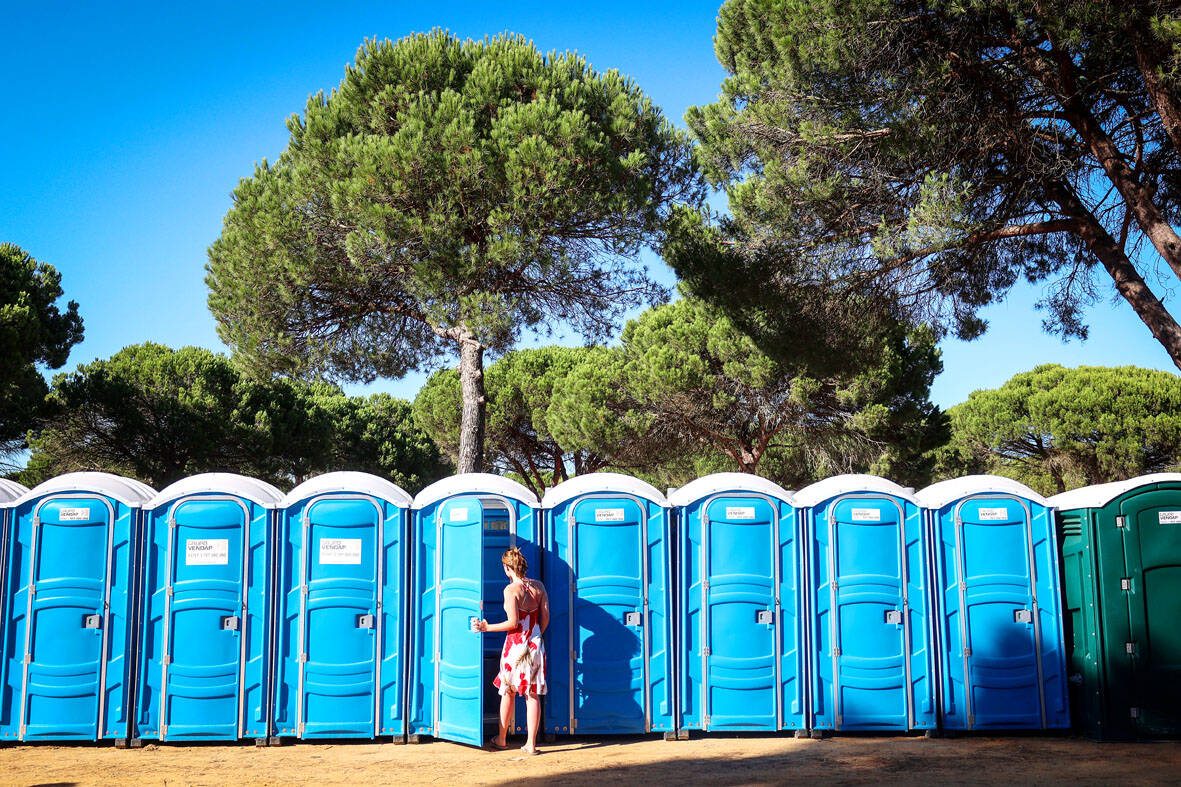In her book Stoic at Work, Annie Lawson tells the story of a colleague of hers hearing someone eating pretzels while sitting on the toilet.
“The person holed up in a toilet cubicle — a senior leader — was gnawing on them like a squirrel, taking several bites per pretzel while doing his business. Then his phone rang and he answered. He was the ultimate multi-tasker. My colleague was at the sink washing his hands when he heard a flush and the senior leader emerged from the cubicle with an empty pretzel packet. He nodded, dropped the pretzel packet in the bin and walked out without washing his hands.”
Is this story so hilarious because of the pretzels, the appalling hygiene deficit or because the man was so shamelessly pooing during work hours?

Photo: EPA-EFE
A social media post by Queensland Health called “It’s okay to poo at work” went viral this week. It started a conversation that people seem to have only with a small and specific cluster of close friends, usually on the understanding that the conversation, unlike the smell coming from that locked stall, will go no further.
Do you poo at work? And if not, why?
It’s tough talking about this, and Queensland Health has been praised broadly for their campaign.
It cut through because there’s a distaste around talking about poo. I respect and understand this. I don’t love poo talk, and won’t allow it at the dinner table, for instance. It would be inappropriate with new friends, or while enjoying a soft serve chocolate ice-cream, or when applying a mud mask to one’s face. Hearing about poo is too evocative and gross in most settings.
But this bodily function, like our naked bottoms, needs occasional time in the sun. If there’s something we need education on, or social change, or if there’s something affecting our health — we have to talk about it.
“The more literacy people have about these functions, the easier it is to discuss with a healthcare professional if things go awry,” says James. “Bowel, gut and pelvic health are core pillars to whole body wellness!”
‘CALL TO STOOL’
She shows me the Bristol stool chart (Google it). We talk through which poos are optimal. That unmistakable feeling in your body of the urge to poo has a medical name: it’s the “call to stool.” It sounds like a shouty punk band, but avoiding the toilet because you’re at work means you’re ignoring this call.
“It’s important to be responsive to ‘the call to stool’ and prioritize getting to the toilet within a few minutes of this sensation. It is when everything is ‘ready to go’ — stool is in the right position, in the anorectum — combined with a complex interplay of pressure from the abdominal region, relaxation of sphincters and the pelvic floor muscles,” James says.
“If there are consistent delays in this timely response to poo/defecate, there will be a reversal of this complex interplay, where the pelvic floor and sphincter tighten, resulting in the stool moving away from the rectum. The stool can then dry out, becoming firmer and harder, resulting in a need for more pressure to defecate the next time the call to stool comes about. This can be up to a 24-hour delay!”
My dad used to theorize about a slowly spinning cylinder inside his belly — picture the cardboard tube inside a roll of kitchen paper. It is rotating slowly. At 24 hours, it aligns with your bumhole. Quick — that’s the call to stool. He used to joke that if you missed the window, you’d have to wait another 24 hours. And after all these years, I realize his jokey theory wasn’t so far off.
TALKING ‘BOUT POO
I hit up the work WhatsApp: “Does anyone feel like talking about shyness/reluctance around pooing at work or public toilets?”
“Thanks for the offer but I’m good,” was one reply.
“My 8-year-old?” was another.
I understood that the circle of people who I can talk to about poo did not include my work friends.
I made a mental shortlist of friends I could bother with this question. Even if they didn’t want to answer — just feeling safe asking the question was a sign our bond was secure. Maybe poo chat is a measure of true friendship and intimacy?
Here are some of the replies:
Reina (all names have been changed): “I was just talking about this with my sister! She never poos in public! For her it’s more to do with hygiene than embarrassment. She’d rather poo at home than spend too long on a public toilet. It’s the seat germs.”
Heidi: “I would definitely poop at work but try to get an empty bathroom stall.”
Katie: “I hate pooing anywhere except at home. Preferably with no one else even in the house. I DON’T KNOW WHY.”
Frank: “I poo at every new workplace as an act of aggression and dominance,” he says (to the delight and approval of the group chat).
Jack: “Not at work! Never ever. Work is a separate realm. It has its own rules and needs. What’s sacred outside work must stay sacred.”
Sam: “I could poo at a friend’s house, yes. However, if the bathroom is in a central area then I’d hold on until the last minute. If it’s around a new partner I’d definitely make up a fake trip to the store or down the street to poop somewhere else. Beautiful people don’t poo.”
The thing I’m taking from this is that people would prefer to answer the Call to Stool with punk rock confidence that they’ll be free of interruption, with privacy and no judgment.
James says the optimal way to poo is with your knees higher than your hips, leaning forward (as though in rapt engagement — my words) and with your abdominal wall lengthened. Short people can benefit from a toilet stool. (That word again!) You set it on the floor of the toilet and put your feet up on it when your cylinder is aligned with the exit strategy. She shows one to me and I end up buying it and taking it home.
Not to work though, obviously.

The canonical shot of an East Asian city is a night skyline studded with towering apartment and office buildings, bright with neon and plastic signage, a landscape of energy and modernity. Another classic image is the same city seen from above, in which identical apartment towers march across the city, spilling out over nearby geography, like stylized soldiers colonizing new territory in a board game. Densely populated dynamic conurbations of money, technological innovation and convenience, it is hard to see the cities of East Asia as what they truly are: necropolises. Why is this? The East Asian development model, with

June 16 to June 22 The following flyer appeared on the streets of Hsinchu on June 12, 1895: “Taipei has already fallen to the Japanese barbarians, who have brought great misery to our land and people. We heard that the Japanese occupiers will tax our gardens, our houses, our bodies, and even our chickens, dogs, cows and pigs. They wear their hair wild, carve their teeth, tattoo their foreheads, wear strange clothes and speak a strange language. How can we be ruled by such people?” Posted by civilian militia leader Wu Tang-hsing (吳湯興), it was a call to arms to retake

This is a deeply unsettling period in Taiwan. Uncertainties are everywhere while everyone waits for a small army of other shoes to drop on nearly every front. During challenging times, interesting political changes can happen, yet all three major political parties are beset with scandals, strife and self-inflicted wounds. As the ruling party, the Democratic Progressive Party (DPP) is held accountable for not only the challenges to the party, but also the nation. Taiwan is geopolitically and economically under threat. Domestically, the administration is under siege by the opposition-controlled legislature and growing discontent with what opponents characterize as arrogant, autocratic

When Lisa, 20, laces into her ultra-high heels for her shift at a strip club in Ukraine’s Kharkiv, she knows that aside from dancing, she will have to comfort traumatized soldiers. Since Russia’s 2022 invasion, exhausted troops are the main clientele of the Flash Dancers club in the center of the northeastern city, just 20 kilometers from Russian forces. For some customers, it provides an “escape” from the war, said Valerya Zavatska — a 25-year-old law graduate who runs the club with her mother, an ex-dancer. But many are not there just for the show. They “want to talk about what hurts,” she